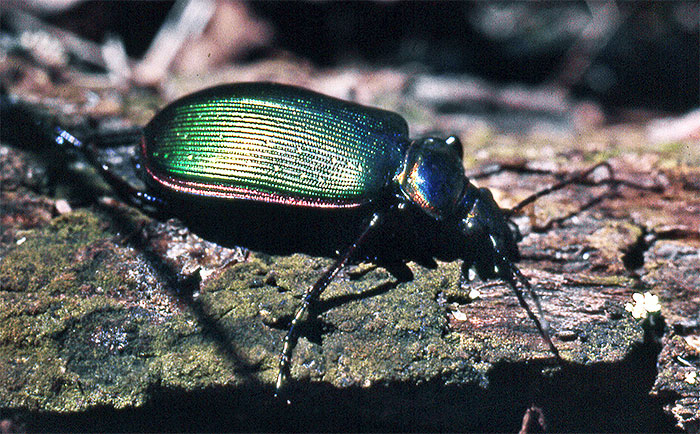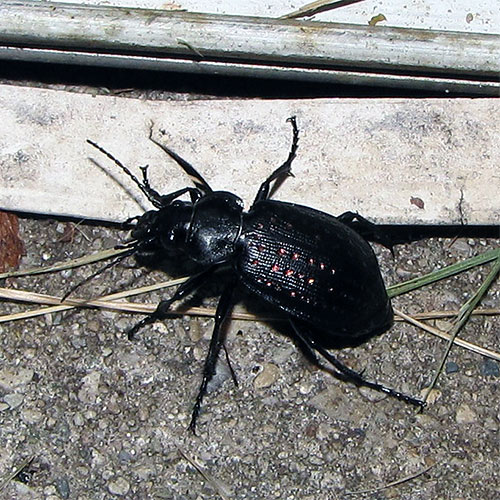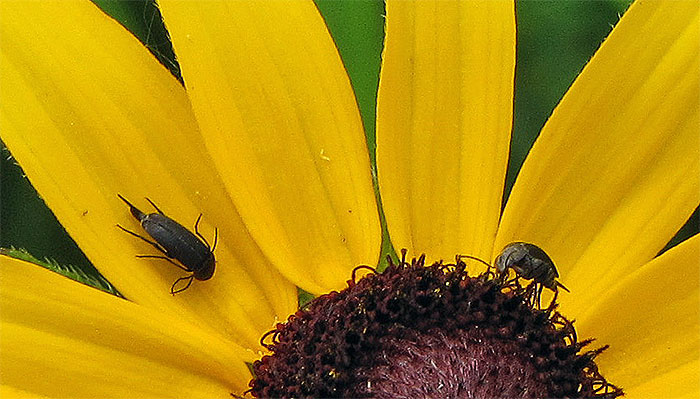Greetings, BugFans,
Today’s episode—”Big Beetle, Tiny Beetle”—shows some of the amazing range of this fantastic (and largest) order of insects.
Fiery Searcher
Ground beetles are in the family Carabidae, which celebrate more than 2,500 species in North America (some say 3,000). Ground beetles are small-headed beetles characterized by a shiny, dark/black coloration and by grooves and/or pits on their elytra (the hardened first pair of wings that protects the membranous, second pair of wings). They come in a variety of sizes and shapes. Many are nocturnal critters that hide during the day in the dark, damp coolness under leaves, logs, bark, debris, etc, and most are predators. Some can be quite long-lived (for a beetle), spending one to three years as larvae (grubs) and one or more years as adults.
Fiery Searchers are in the genus Calosoma, which is considered by some to contain some of the most beautiful beetles on the continent. They can be huge (up to about 1 ½”), with names like “Searcher,” “Caterpillar Hunter,” “Fiery Hunter,” and various combinations thereof. The common names seem to be pretty much interchangeable rom species to species.
According to Eaton and Kaufman in the Field Guide to Insects of North America, members of the genus Calosoma are called Searchers because of their feverish hunting behavior. Fiery Searchers, young and old, prey on caterpillars; adults may perambulate during the day, but the larvae hunt only at night. In some species, like C. scrutator, only the adult chases up trees after caterpillars; in others, like C. calidum, the immature beetle climbs, too—an unusual behavior for a beetle larva. One of their favorite menu items is tent caterpillars, of previous BOTW fame, and a European Calosoma has been imported to climb up forest trees and feed on gypsy moths. In The Handy Bug Answer Book, Waldbauer tells of a Calosoma larva which personally tucked into 50 full-grown (2 ½”) gypsy moth caterpillars during its two-week larval period, and he says that during a multi-year adult life, a beetle may eat several hundred more.
Ground beetles have the ability to discourage potential predators by spraying at them a chemical that has been variously described as “fetid,” “smelly” and “blistering;” in fact, some suggest that the “Fiery” part of their name comes not from their iridescent coloration but from their chemical defense system.
Tumbling Flower Beetles
Tumbling Flower beetles (TFBs) always reminds the BugLady of a flea on a flower. TFBs are small, active, generally dark, caraway-seed-shaped beetles in the Tumbling Flower beetle family, Mordellidae, a family with some very fine genus names like Mordellistena, Hoshihananomia, and Yakuhananomia.
They have long legs (the better to tumble with, my dear) and “hump-backed” bodies, with their heads angled down almost under the first segment of the thorax (in a “pre-somersault” position). TFBs are “flattened” from side to side, and wedge-shaped (tapered toward their pointy rears) and are covered with short hairs that are silky and slippery and that may give them an iridescent shine. The TFBs can be a very confusing bunch; to tell the difference between some of the species, you have to count the ridges on the hind tibia and tarsi (legs and feet).
Adult TFBs feed on fungi and on pollen, especially on plants in the aster and carrot families. Their larvae inhabit and feed on dead wood, the pith of herbaceous plants, and woody fungi (and a few species may be predaceous). Plant-pith-eating larvae are sometimes found inside plant galls. By themselves, the larvae seldom damage plants, but when they join other species of stem-boring insects, the overall infestation can be harmful. TFBs are said to be very aggressive against other TFBs.
Do they tumble? Oh my, yes. When alarmed, which seems to be often, they bail, letting go of the flower and tumbling or jumping off. Part way down, they may spread their wings and fly (they are good flyers) or they may fall all the way to the ground, where they are impossible to find.
The BugLady


